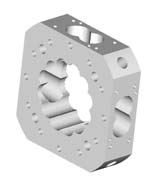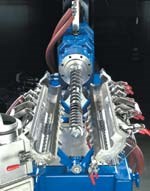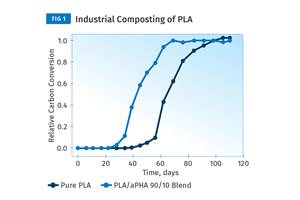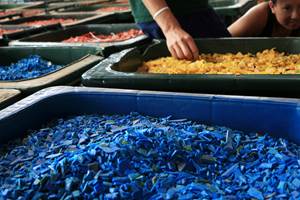Twin-Screws & Kneaders Pack More Muscle
This K show demonstrated the continuing evolution toward higher torque, screw speed, and throughput rates in twin-screw compounders. There were also new developments for reducing wear when processing filled compounds and new processes available for license to compound wood and paper fibers with plastics. There were even some improvements in backflushing screen changers.
Hunger for higher torque
Thyssen Henschel (U.S. office in Green Bay, Wis.) has applied for patents on a new generation of higher-torque gearboxes for extruders. The first of these, called T1Max, can provide a torque factor (torque divided by the center distance cubed) of up to 20 per shaft for a counter-rotating twin-screw machine. Even newer is the T2Max, which has a torque factor of up to 25 per shaft for counter-rotating twin-screws and 17 to 20 per shaft for corotating twins. The first T2Max gearboxes have just been sold to American Maplan in McPherson, Kan., for counter-rotating machines and to Entek in Lebanon, Ore., for corotating twin-screws. Counter-rotating gearboxes typically run at high torque and low speed (30 to 60 rpm), while corotating models run at high speed (up to 1300 rpm) and lower torque.
Another application of Thyssen's new gearbox is on the new "TwinPower" corotating twin-screw extruder from Cpm Compounding Processing Machinery GmbH in Grossefehn, Germany. Cpm says this machine has the highest torque in the world. It runs at relatively low speeds—300 rpm maximum—with a torque factor of 16, which is 50% higher than the highest current torque ratios of about 11, Cpm says. Cpm has delivered two of these new extruders.
Cpm's new extruder also uses solid, one-piece screws in order to handle the higher torque without snapping. A number of manufacturers offer such screws. They are stronger and much less expensive than segmented ones, but don't offer the flexibility to be reconfigured for different compounds.
Leistritz Extrusionstechnik (U.S. office in Somerville, N.J.) brought to the show its largest high-speed, high-torque model built to date, which has 110-mm-diam. segmented screws. It is also the company's first machine with a water-cooled AC motor. Leistritz's largest high-speed, high-torque model until now has 80-mm screws.
Berstorff GmbH (U.S. office in Florence, Ky.) showed its new model ZE60A-UTX with 40:1 L/D and top speed of 1200 rpm. Its drive train and gearing have been redesigned for higher torque potential. Also, Berstroff announced a 40% torque increase for its existing ZE-R twin-screw with high free volume.
APV Baker of the U.K., with a new U.S. office in Grand Rapids, Mich., has doubled the previous maximum screw speed of its AC (Advanced Compounder) Series corotating twin-screw machine since it was first introduced at K'98. With a new drive and gearbox from parent company Invensys, Model MP 50AC now can achieve 1200 rpm.
In its newest generation of corotating twin-screws, Coperion Werner & Pfleiderer (U.S. office in Ramsey, N.J.) focuses on increasing throughput rate by means other than higher torque. Screw modifications on the new ZSK Megavolume series allow 50% higher free volume while the torque capacity has been kept at the same level as on Coperion's existing Megacompounder. The result can be up to 50% higher output. The Megavolume machine reportedly runs even highly abrasive filled compounds at 1200 rpm. It runs low-bulk-density materials as fast as 1800 rpm vs. 1200 rpm for the standard Megacompounder.
PVC kneader overhauled
For PVC compounding, the Buss Kneader from Coperion Buss AG in Pratteln, Switzerland (U.S. office in Ramsey, N.J.) came out with the first major redesign in more than 50 years. The new design, called Quantec, has up to three times higher output rate than before and costs 30% less. Among several design and construction improvements, it is now fed by a simple gravity-feed hopper instead of the previous crammer feeding. The barrel feed port is now also five times larger. Eliminating the crammer auger reduces cost and no longer compacts the PVC dryblend, so air escapes more easily out of the feed opening.
The initial compression zone of the kneader is also redesigned with a tapered screw that allows five times higher free volume. Before, the whole screw had a constant diameter. Fixed barrel pins have also been added in the compression section to clean the screw.
The biggest change is in the mixing section of the screw, where the addition of a fourth row of pins increases conveying capacity. With only three rows of pins on the screw, gaps in the interrupted kneading flights lined up in a row. Now the gaps are staggered, so the kneading flights overlap and form a labyrinth that greatly reduces backflow.
Compounding wood & paper
Sin Yong Guan Industries, a PVC profile extruder in Malaysia, showed off its T-Wood technology for making 30% wood-filled and foamed PVC profiles for building-interior woodwork and trim. It has a density of 0.65 to 0.7 g/cc and a remarkably woodlike surface finish. The process has been commercial for nearly five years in Malaysia and is available for license in other markets. Sin Yong uses both single- and twin-screw extruders.
Cycle Tec Ltd. of Israel (U.S. office at Cycle Tec Advanced Applications in Chicago) is licensing its new twin-screw process that combines HDPE with granulated newspaper to create fiber composites for matched-die molding. Applications under development in North America include pallets and automotive parts. A pilot plant in Israel is currently testing composites made from gabletop and aseptic drink cartons. The process uses a corotating twin-screw extruder with a twin-screw side feeder to add dried, ground newsprint just before the die.
More than two screws
Design modifications are said to improve performance of the 12 self-wiping screws mounted in a ring around a stationary core on the 32:1 RingExtruder from 3+ Extruder GmbH. The company has eliminated kneading blocks and now uses simple conveying sections for the length of the screw to achieve more elongational flow and faster mixing of high- and low-viscosity materials. Also, the four barrel sections are redesigned so that each can accommodate two twin-screw side feeders for a total of up to eight on one machine—an advantage in masterbatch production. The company's U.S. licensee, Century Specialties in Traverse City, Mich., has built two of the 12-screw machines. The first started up just before the K show.
Keeping screens clean
Gneuss Kunststofftechnnik GmbH (U.S. office in Matthews, N.C.) introduced a new adapter for its automatic screen changers that permits fast connects and disconnects. It was shown on the biggest RSFgenius screen changer Gneuss has built to date. It handles up to 22,000 lb/hr. It takes two pistons firing together to backflush the unit at pressures up to 871 psi. The first commercial installation was for compounding PBT for fiber-optic sheathing, which requires high cleanliness.
Econ Maschinenbau & Steuerungstechnik GmbH is a two-year-old company in Haid/Ansfelden, Austria, that is looking for a U.S. representative. It showed off a new backflushing screen changer that reportedly needs less pressure to clean than most models. For applications with limited contamination, it uses a small secondary piston to clean the screen pack.
Related Content
Blend Amorphous PHA with PLA to Improve injection Molded Part Properties
Adding aPHA to PLA can boost a range of mechanical properties and expedite composting. Here are the details as well as processing guidelines for injection molding the blends.
Read MoreAt NPE2024, Follow These Megatrends in Materials and Additives
Offerings range from recycled, biobased, biodegradable and monomaterial structures that enhance recyclability to additives that are more efficient, sustainable and safer to use.
Read MoreAvantium and U.S.’s Origin Materials Aim to Accelerate Production of FDCA and PEF
The partnership aims to bring together both companies’ technology platforms to produce FDCA from sustainable wood residues on an industrial scale.
Read MoreBest Practices for Purging PHA and PHA/PLA Blends
Because bioplastics are processed at lower temperatures, purging between jobs requires a different process and purging agents than those applied for traditional resins.
Read MoreRead Next
See Recyclers Close the Loop on Trade Show Production Scrap at NPE2024
A collaboration between show organizer PLASTICS, recycler CPR and size reduction experts WEIMA and Conair recovered and recycled all production scrap at NPE2024.
Read MoreMaking the Circular Economy a Reality
Driven by brand owner demands and new worldwide legislation, the entire supply chain is working toward the shift to circularity, with some evidence the circular economy has already begun.
Read MoreLead the Conversation, Change the Conversation
Coverage of single-use plastics can be both misleading and demoralizing. Here are 10 tips for changing the perception of the plastics industry at your company and in your community.
Read More
















